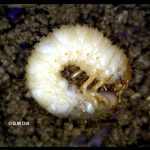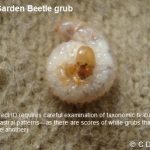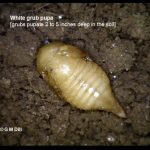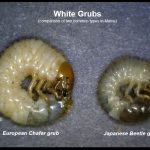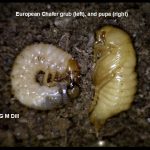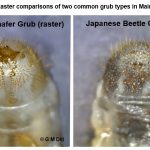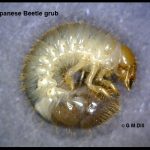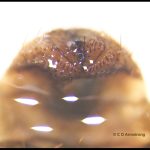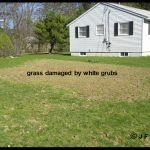White Grubs
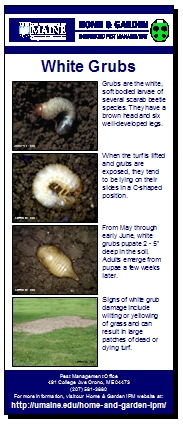
White grubs are the white, soft-bodied larvae of several scarab beetle species, including European chafer, Japanese beetle, May/June beetles, Asiatic garden beetle, and Oriental Beetle. They have a brown head and six well-developed legs. When the turf is lifted and grubs are exposed, they tend to be lying on their sides in a C-shaped position. From May through early June, white grubs pupate 2 – 5″ deep in the soil. Adults emerge from pupae a few weeks later. Signs of white grub damage include wilting or yellowing of grass and can result in large patches of dead or dying turf.
Life Cycle:
The adult beetle lays its eggs in the ground during the summer. As the grubs hatch, they start to feed on the roots until cold weather drives them two to eight inches deeper into the soil where they overwinter. When Spring arrives, the grubs move up from the lower soil regions and resume feeding near the surface until they become mature and pupate from late May through early June. As the grubs near pupation, their feeding will subside, so new grass can be safely reseeded by the end of May, if desired. In the case of Japanese beetle, it is worth noting that most of the feeding done by those particular grubs occurs in the fall (they feed very little in the spring).
How many is too many?
This depends on several factors, and not all grubs are created equal. Larger grub species will likewise consume a greater amount of total root material as they near maturity, so it’s helpful to know which species of grub is present. The grub of the May/June beetle is very common in Maine, and since that species grows to be relatively large in size compared to other species, it takes fewer grubs to equal the same amount of feeding damage versus that of a smaller species. Thus, the general guidance for May/June beetle grubs is that treatment is warranted with a level of only three or four grubs per square foot. If the grubs you are finding are big, it’s reasonable to adopt that threshold of three or four grubs per square foot of soil. On the other end of the spectrum is the Asiatic Garden beetle; a smaller species that is also common in Maine and New England. The treatment level for that species is 18 to 20 grubs per square foot. The overall general health of the grass is also an important consideration to the question of how many is too many. Grass that is stressed due to adverse climatic conditions (too wet or too dry, for example) or other adverse environmental conditions will be more susceptible to significant damage from a lower level of grub activity.
Management [Read & Follow All Pesticide Label Directions!]:
Curative controls are applied when the grubs are present. Common curatives include carbaryl, which is not consistently effective, and trichlorfon. Trichlorfon has to be applied by a licensed professional and kills, at best, 50% of the mature grubs and does not protect the lawn from the next generation of grubs. Until recently, various systemic neonicotinoid products were a common choice applied to lawns as a preventative control, but in 2021 the Maine Board of Pesticides Control (BPC) adopted a regulation to make certain neonicotinoids “restricted use.” Consequently, all pesticides with the active ingredients dinotefuran, clothianidin, imidacloprid or thiamethoxam are prohibited from use by all persons in outdoor residential landscapes such as lawn, turf, and ornamental vegetation. There are some (but not many) exemptions to the rule. One notable exemption is for licensed individuals treating “emerging invasive invertebrate pests” on ornamental vegetation. As of the fall of 2023, the following three pests are included in that list: Asian long-horned beetle (Anoplophora glabripennis), Emerald ash borer (Agrilus planipennis), and Hemlock woolly adelgid (Adelges tsugae). To be clear, none of those are “white grubs.” For more information about the BPC’s 2021 rule, including all of the exemptions, go to: https://www.maine.gov/dacf/php/pesticides/applicators/neonicotinoids.shtml
Chlorantraniliprole (see fact sheet below) (e.g. Acelepryn®, GrubEx1®) is an example of a preventative, systemic compound that falls into a different class of chemical–Group 28–known as anthranilic diamides (i.e. it is not a neonicotinoid). It is a very selective, narrow-spectrum compound with a novel mode of action that works on the insect’s muscular system rather than its nervous system. Chlorantraniliprole products should be applied about three weeks in advance of any feeding activity by grubs because it needs ample time to become fully incorporated into the roots of the plants (it works primarily via ingestion of the chemical rather than by contact alone). Thus, to target the first active grubs of the season–which in Maine typically begin feeding in mid-May–chlorantraniliprole would ideally need to be applied approximately late April to ensure that the chemical is in the roots when our May/June beetle grubs move back up into the root zone to feed. Some people also apply it in June (to new or healthy grass not yet harmed by any prior wave of grubs the previous month) in order to proactively protect that grass from the subsequent generation of new grubs that hatch from eggs in the soil later in the summer. Chlorantraniliprole, coincidentally, will also control the larvae of crane flies, which also feed on the roots of grasses. If you wait until you see the symptoms of dying/browning grass, with either beetle grubs or crane fly larvae already actively feeding, it’s too late at that point to use chlorantraniliprole and expect to see any control or improvement. Also of note regarding the use of chlorantraniliprole in Maine (if you are close to any bodies of water) is the fact that it is highly toxic to aquatic invertebrates, which of course includes lobsters, crawfish, and freshwater aquatic insect larvae such as chironomids (non-biting midges), an important food source for fish.
Organic options for white grubs include beneficial nematodes, products with Bacillus thuringiensis galleriae, or simply letting crows, skunks and raccoons dig up the grubs and then replanting the grass in late May by which time most of the grubs will have pupated. Beneficial nematodes of the Hb variety (applied during the last week of August) are relatively effective compared to other available nematode varieties. Nematodes should be used on low-value turf because their effectiveness can be spotty. Bacillus thuringiensis galleriae, often abbreviated as Btg, is a naturally occurring bacterial product that reportedly works well against all species of scarab grubs.
- Examples of White Grubs
- White Grub
- Asiatic Garden Beetle Grub
- Pupa of a White Grub
- Comparing grubs of European Chafer and Japanese Beetle
- European Chafer (grub and pupa)
- Comparing the rasters of Japanese Beetle and European Chafer grubs.
- Japanese Beetle Larva/Grub
- Posterior end (raster) of an Asiatic Garden Beetle grub from Northeast Harbor, ME; 4/22/2024
- White Grub damage to a lawn
- White Grub damage to a lawn
- White Grub damage to a lawn
Additional Information:
- Chlorantraniliprole Fact Sheet (National Pesticide Information Center)
- Very helpful: White Grubs (Cornell) (includes some month-specific guidance depending on what month it is when you are finding the grubs)
- Grubs in your lawn? A guide for lawn care professionals and homeowners (Cornell)
- White Grubs in Vegetables (UMaine Cooperative Extension)
- Photo comparing the raster pattern of various White Grubs (Purdue)
- Identifying White Grubs (pdf) (Michigan State University)
- Identification of White Grubs in Turfgrass (Ohio State University Extension)
- White Grubs in Lawns (Frequently-asked Questions) (University of Illinois)
- White Grubs in Lawns (Penn State)
Here is a list of Maine’s most common beetle grubs (Family Scarabidae) and their associated treatment thresholds for turf/lawns. These grubs are often collectively referred to as ‘White Grubs’:
- May and June Beetle grubs (genus Phyllophaga) (Texas A&M) (treatment threshold is generally 3 to 4 per square foot but as high as 10 per square foot if the turf is well maintained with irrigation, fertilizers, etc.) (includes a link to a YouTube video of a May/June beetle grub)
- Examples of adult beetles from the Phyllophaga genus:
- Lesser June Beetle (BugGuide.net)
- Northern June Beetle (BugGuide.net)
- Cranberry White Grub Beetle (BugGuide.net)
- Examples of adult beetles from the Phyllophaga genus:
- Asiatic Garden Beetle (treatment threshold is 18 to 20 grubs per square foot)
- European Chafer grubs (treatment threshold is 5 to 8 per square foot)
- Japanese Beetle grubs (Michigan State University) (treatment threshold is 8 to 10 per square foot) — see also Japanese Beetles in the Home Garden (Penn State) and Plant Tolerance of Japanese Beetles
- Oriental Beetle (NC State Extension) (treatment threshold is 8 grubs per square foot; this species is more common in southernmost portions of Maine versus elsewhere in Maine)


